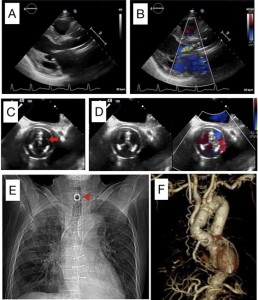<Title:> Reoperative Aortic Valve Replacement for Structural Valve Deterioration through a Lower Hemisternotomy after a Previous Bentall Procedure in a Patient with Tracheostomy
<Author(s):> Kaori Katsumata, Yujiro Kawai, Tsutomu Ito, Hideyuki Shimizu
<Corresponding author E-Mill:> yujiro.roadster(at)gmail.com
<Abstract:> Patients with tracheostomy who undergo a full sternotomy have an increased risk of mediastinitis and sternal infection. This report describes a reoperative aortic valve replacement (re-AVR) for structural valve deterioration (SVD) through a lower hemisternotomy. This procedure was performed on a 71-year-old man with a tracheostomy who had previously undergone a Bentall procedure with a bioprosthetic valve to replace an enlarged ascending aortic aneurysm. Comorbidities included chronic renal failure requiring hemodialysis. Fourteen months after the Bentall procedure, the patient presented with sudden dyspnea and was transferred to another hospital. Upon suffering acute heart failure, the patient required mechanical ventilation and was transferred to our hospital for intubation. The patient subsequently developed severe pneumonia. As a result of prolonged ventilation, the patient underwent tracheostomy and was administered antibiotic medication (piperacillin/tazobactam) for pneumonia. Echocardiography revealed severe aortic regurgitation caused by SVD. There was a risk that a full sternotomy in a patient with tracheostomy could cause mediastinitis; therefore, we performed a re-AVR through a lower hemisternotomy (second T incision). The re-AVR surgery proceeded without complications, and the bioprosthetic valve was removed while preserving the vascular graft from the previous Bentall procedure. The postoperative course was uneventful, and the patient was discharged from hospital 31 days after the tracheostomy was closed. The success of this procedure demonstrates the viability of re-AVR through a lower hemisternotomy in patients with SVD who are at risk of additional surgical complications.
<Keywords:> lower hemisternotomy, tracheostomy, reoperative aortic valve replacement, Bentall procedure
<URL:> https://www.jstage.jst.go.jp/article/kjm/advpub/0/advpub_2022-0009-CR/_html


![Targeting DNA Methylation in Podocytes to Overcome Chronic Kidney Disease [Published online Keio J Med, 72, 67-76, by J-STAGE]](http://kjm.pupu.jp/blog/wp-content/uploads/2023/09/2022-0017-IR-100x100.jpg)
![Correlation of the Blood Test Results Obtained between Assays Using Microliter-scale Fingertip Blood Samples Collected with a Novel Blood Collection Device and Conventional Venous Blood Assays: a Secondary Publication in English [Published online in advanced , by J-STAGE]](http://kjm.pupu.jp/blog/wp-content/uploads/2017/11/2017-0009-OA-100x100.jpg)
![Surgical training and research in the Netherlands [Published online Keio J Med, 68, 68-68, by J-STAGE]](http://kjm.pupu.jp/blog/wp-content/uploads/2019/09/68-005-ABST-100x100.jpg)
![Pupil Dynamics-derived Sleep Stage Classification of a Head-fixed Mouse Using a Recurrent Neural Network [Published online Keio J Med, 72, 44-59, by J-STAGE]](http://kjm.pupu.jp/blog/wp-content/uploads/2023/06/2022-0020-OA-100x100.jpg)
![Long-term Spontaneous Partial Regression of a Cerebral Arteriovenous Malformation: 24-Year Follow-up [Published online Keio J Med, 66, 51-53, by J-STAGE]](http://kjm.pupu.jp/blog/wp-content/uploads/2017/09/2016-0010-CR-100x100.jpg)
![Clinical Serum Therapy: Benefits, Cautions, and Potential Applications [Published online in advanced , by J-STAGE]](http://kjm.pupu.jp/blog/wp-content/uploads/2017/04/2016-0017-IR-100x100.jpg)
![Body Motion and Rowing Performance: Association between Hip Angle and Rowing Performance: A Pilot Study [Published online in advanced , by J-STAGE]](http://kjm.pupu.jp/blog/wp-content/uploads/2020/01/2019-0007-OA-100x100.jpg)
![Rivaroxaban Promotes Reduction of Embolus Size within Cerebrocortical Microvessels in a Mouse Model of Embolic Stroke [Published online Keio J Med, 68, 45-53, by J-STAGE]](http://kjm.pupu.jp/blog/wp-content/uploads/2019/09/2018-0010-OA-100x100.jpg)
![Stroke and the Cell Therapy Saga: Towards a Safe, Swift and Efficient Utilization of cells [Published online Keio J Med, 66, 55-55, by J-STAGE]](http://kjm.pupu.jp/blog/wp-content/uploads/2017/09/66-005-ABST-100x100.jpg)
![Current Management of Chronic Constipation in Japan [Published online in advanced , by J-STAGE]](http://kjm.pupu.jp/blog/wp-content/uploads/2023/09/2022-0036-IR-100x100.jpg)